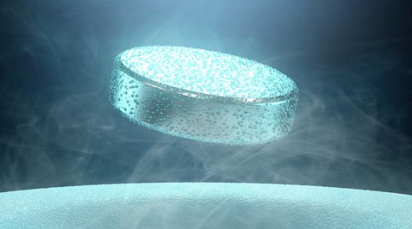Discovery: High-temperature superconductivity was first discovered in 1986 by Johannes Georg Bednorz and Karl Alexander Müller, who found that a ceramic material, a lanthanum barium copper oxide (LaBaCuO), became superconductive at 35 Kelvin. Their discovery earned them the Nobel Prize in Physics in 1987.
Physicists have recently observed a critical feature of superconductivity at temperatures much higher than previously thought possible, opening new doors for the development of more practical and efficient superconductors. This discovery revolves around the behavior of electrons in a specific material, revealing potential pathways toward achieving superconductivity at higher, more manageable temperatures.
Physicists find superconductor behavior at temperatures once thought ‘impossible’ https://t.co/64zGCIo8de
— marylynnjuszczak (@marylynnjuszcza) August 21, 2024
Superconductivity is a phenomenon where electrons move through a material without any resistance, resulting in zero energy loss. Typically, this occurs only at extremely low temperatures, close to absolute zero (-273.15°C or -460°F), or at slightly higher temperatures under immense pressure. However, a new study has observed the pairing of electrons—an essential step toward superconductivity—in a material at temperatures much higher than those required for conventional superconductors.
The material in question is neodymium cerium copper oxide (Nd2−xCexCuO4), a layered, copper-based crystal known as a cuprate. While this crystal exhibits superconductivity at low temperatures, it becomes significantly more resistant as the temperature rises. The researchers found that even though the electrons in this material didn’t achieve resistance-free flow, they did form what are known as Cooper pairs—entangled quantum states of electrons that are essential for superconductivity.
“The electron pairs are telling us that they are ready to be superconducting, but something is stopping them,” explains physicist Ke-Jun Xu of Stanford University. “If we can find a new method to synchronize the pairs, we could apply that to possibly building higher temperature superconductors.”
In conventional superconductors, which function below around 25 Kelvin (-248°C or -415°F), electron pairing is induced by vibrations within the material. Cuprates, however, are unconventional superconductors that can exhibit this phenomenon at temperatures up to 130 Kelvin. The exact mechanism behind electron pairing in cuprates remains unclear, making this discovery particularly intriguing.
The study found that neodymium cerium copper oxide retains more energy at temperatures up to 140 Kelvin (-133°C or -207°F), suggesting that Cooper pairs form at these higher temperatures. While this material may not be the one to achieve room temperature superconductivity, it provides valuable insights that could lead to future breakthroughs.
Superconductivity at ambient temperatures would revolutionize technology, enabling 100 percent energy efficiency and allowing for smaller, more powerful circuitry. Despite numerous claimed breakthroughs, including the much-hyped LK-99, achieving room temperature superconductivity has proven elusive.
Quantum Leap in Superconductivity As Electrons Pair at Higher Temperatures. Recent research has identified electron pairing, a core superconductor behavior, in materials at higher-than-expected temperatures, such as an antiferromagnetic insulator.
This discovery by SLAC and… pic.twitter.com/0dOrvPfMf8
— Nirmata (@En_formare) August 21, 2024
The recent findings offer a promising step forward. “Our findings open a potentially rich new path forward,” says physicist Zhi-Xun Shen of Stanford University. The research team plans to further study this pairing gap to better understand the process and explore methods to synchronize these electron pairs, potentially paving the way for the development of higher-temperature superconductors.
More Facts
Definition: High-temperature superconductivity refers to the phenomenon where certain materials can conduct electricity without resistance at relatively high temperatures (above 30 Kelvin or -243.15°C), which is much higher than the temperatures required for traditional superconductors (typically close to absolute zero).
- Materials: The most well-known high-temperature superconductors are copper oxide-based ceramics, known as cuprates. Another notable family of high-temperature superconductors is the iron-based superconductors, discovered in 2008.
- Applications: High-temperature superconductors have potential applications in various fields, including magnetic resonance imaging (MRI), power grids, maglev trains, and quantum computing, due to their ability to carry large amounts of current with no loss of energy.
- Challenges: Despite their potential, high-temperature superconductors face challenges in widespread application. The cooling required, even though less extreme than for traditional superconductors, still involves complex and expensive cryogenics. Additionally, understanding the exact mechanism behind high-temperature superconductivity remains one of the significant unsolved problems in physics.
Quotes
- Paul Chu (Physicist known for his work in superconductivity): “High-temperature superconductors are not just a scientific curiosity; they hold the potential to revolutionize energy distribution, making it more efficient and sustainable.”
- Philip W. Anderson (Nobel Laureate in Physics, who contributed significantly to the theoretical understanding of superconductivity): “The mechanism of high-temperature superconductivity is likely the most important unsolved problem in all of solid-state physics.”
- David Pines (Theoretical physicist, co-developer of theories on superconductivity): “The discovery of high-temperature superconductivity has been one of the most exciting and puzzling developments in condensed matter physics. Its implications for both fundamental science and practical applications are enormous.”
Key Points:
i. Physicists have observed a critical feature of superconductivity at much higher temperatures than previously thought possible in a material called neodymium cerium copper oxide.
ii. The study found that even at higher temperatures, electrons in the material form Cooper pairs, a crucial step toward achieving superconductivity.
iii. discovery could lead to the development of superconductors that operate at higher, more practical temperatures, reducing the need for extreme cooling.
iv. Superconductivity at ambient temperatures could revolutionize technology, offering 100 percent energy efficiency and more compact, powerful circuitry.
v. The researchers plan to continue studying this phenomenon, hoping to find ways to manipulate materials to achieve synchronized electron pairing and ultimately, high-temperature superconductivity.
Jacon H Joulous – Reprinted with permission of Whatfinger News


